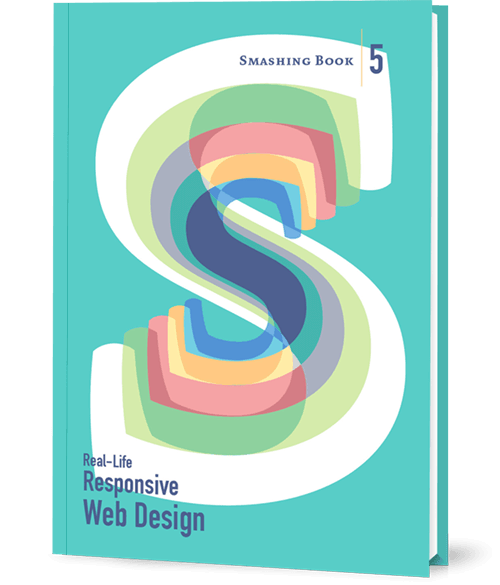That’s Real-Life Responsive Web Design: Meet The Brand New Smashing Book 5
Smart “responsive” workflows, effective responsive design/UX patterns and powerful front-end techniques — if you need a good book on smart responsive design, our brand new Smashing Book 5 is just what you need. Neatly packed in a gorgeous hardcover, it covers time-saving, practical techniques for crafting fast, maintainable and scalable responsive websites. 584 pages, hardcover. Free worldwide airmail shipping. Get the book.

eBook
DRM-free, of course.
ePUB, Kindle, PDF.
Included with your Smashing Membership.
Download PDF, ePUB, Kindle.
Thanks for being smashing! ❤️
About The Book
Responsive design is a default these days, but we are all still figuring out just the right process and techniques to better craft responsive websites. That’s why we created a new book — to gather practical techniques and strategies from people who have learned how to get things done right, in actual projects with actual real-world challenges.
Just like all of our Smashing Books, the book isn’t concerned with trends or short-lived workarounds. It focuses on the actual design process — the why of the decisions we make as we craft websites. Think of it as a reliable playbook for issues that keep popping up in every responsive project — just the playbook you need to master all the tricky facets and hurdles of responsive design.

This book won’t solve every single issue in your responsive projects, but it will help you deal with common challenges effectively: be it front-end architecture, layout issues, resolution-independent assets, performance issues, responsive images or pretty much everything else related to responsive design. Shipping worldwide. Available as print and eBook.
Testimonials From Our Readers
- “Smashing Book #5 is now your RWD bible. Stop searching, buy this book, and spend a weekend filling your brain with the most useful, technical information on RWD you can find anywhere.”
— Paul Scrivens - “Hands down the best web development book I’ve ever read.”
— Kent Kadim - “We love this book! @smashingmag Esp.the chapter about #SVG by @SaraSoueidan ???”
— Aga Naplocha - “The ‘Responsive Email’ chapter in the latest @smashingmag book has proven itself worth its weight in gold; cover price value well earned!”
— Tom Jepson
Table Of Contents
We invited respected designers and developers who know a thing or two about designing and building responsive websites. The chapters have also been reviewed by active members of the community such as Jake Archibald and Dmitry Baranovsky — just to name a few.
| AUTHOR | CHAPTER | DETAILS |
|---|---|---|
| Vitaly Friedman | Preface | |
Summary • As designers and developers, we solve problems for a living. Yet, these problems are often quite tricky and complex, and the context of these problems requires us to be creative and flexible in our workflows. With responsive design, we are prompted to create scalable design systems that work well in unpredictable environments. To do that, we need to be pragmatic and find solutions that work well within given constraints. That’s why we created this book: to find techniques that have actually worked in real-life projects with real-world challenges. Keywords • design systems • scalability • bulletproof solutions • front-end techniques • real-world challenges | ||
| Daniel Mall | Responsive Designer’s Workflow | |
Summary • In practice, responsive projects usually require more time, more skills, more testing and hence more flexibility in budgets. Addings changes late delays projects immensely, and process involving designers, developers and clients is usually tiring to say the least. Keywords • responsive workflow • element collage • style tiles • tools • deliverables • performance budget • interface inventory • sketching • planning • manifestos • hypothesis • atomic design • designing in the browser • Photoshop | ||
| Vitaly Friedman | Responsive Design Patterns and Components | |
Summary • So, how do we deal with complex tables when building responsive websites? What about advanced interface components? Dashboards? What about the behaviour of web forms, navigation, mega-drop down menus, filters? Can we utilize vertical media queries and portrait/landscape orientation change? In this chapter, Vitaly will provide an overview of clever practical techniques for improving UX of responsive sites, with innovative approaches to designing "responsive modules" such as mega-drop downs, tables, calendars, accordions, maps, sliders, responsive PDF and responsive iconography — and a dash of anti-patterns to avoid as well. Keywords • design patterns • navigation • smart front-end techniques • priority+ pattern • improved off-canvas • lazy loading • autocomplete • filters • responsive PDF • portrait/landscape mode • sliders • country selector • responsive iconography. | ||
| Eileen Webb | Structured Content For RWD | |
Summary • Content created by one department is never updated by the next. Services get renamed in the navigation, but are still referenced by the old name in the body text. Important information is buried in the murky depths of flowery prose. Keywords • structured content • content consistency • content models • structural audit • editorial content • content types • content relationships • data-driven gaps • feature-driven gaps • authors and editors • CMS • content maintenance | ||
| Sara Soueidan | Mastering SVG For RWD And Beyond | |
Summary • This chapter has hands down on everything you need to know in order to start designing and building flexible components and visual assets with SVG. Sara will take you on a journey through SVG syntax, SVG accessibility, SVG viewport and viewBox, creating and exporting SVGs, embedding SVGs, building SVG sprites, creating SVG icon systems, using SVG Data URIs, optimizing SVG for performance, SVG conditional processing, clever SVG tricks and techniques and making SVG cross-browser responsive with CSS. Yep, everything you need to know about SVG, as promised. Keywords • SVG • syntax • accessibility • viewport • viewBox • exporting • embedding • sprites • icon systems • data URIs • performance • smart SVG techniques • responsive iconography • cross-browser fallbacks | ||
| Zoe M. Gillenwater | Building Responsive Components With Flexbox | |
Summary • We can use Flexbox for a while now. In fact, Flexbox solves a lot of CSS shortcomings and makes building responsive layouts much easier than with floats or positioning. It gives you more control over the things you care about in a responsive layout (such as order, alignment, and proportional sizes of your boxes) and lets the browser figure out the rest; the math-y stuff that computers are good at, like the exact dimensions that are needed on the boxes to perfectly fill the available space. Keywords • syntax variants • | ||
| Bram Stein | Web Fonts Performance | |
Summary • By default, web fonts block rendering, hiding content from the user. The only way to make content accessible as soon as possible is by treating web fonts as a progressive enhancement. This doesn’t mean web font performance is not an issue. You still need to load web fonts as quickly as possible so that users experience your site exactly how you designed and built it. Let's fix this. Keywords • font formats • font loading • font-rendering • FOIT and FOUT • Font Loading API • fallback fonts • inlining fonts • simulating swapping • promises • asynchronous loading and caching • prioritized loading | ||
| Yoav Weiss | Using Responsive Images, Today | |
Summary • So you want to serve different images to different screens. Perhaps a Retina image (only) to Retina screens, or an art-directed image to small screens, or a portrait image for portrait orientation, or perhaps .webp to browsers supporting the format — without performance hits. Since images are the heaviest assets on the web, dealing with them intelligently is both our responsibility and opportunity for more dynamic layouts. That's what native responsive images are for. Keywords • CSS pixel and DPR • Retina displays • fixed-width images • variable-width images • srcset and sizes • art direction • <picture> element • separation of concerns • image format fallback • accessibility • background images • image optimization • WebP and JPEG-XR • compressive images • deployment • common pitfalls | ||
| Fabio Carneiro | The Dark Side Of Responsive HTML Email | |
Summary • Explaining responsive HTML email is always an uphill battle, because just about every single designer and developer hates it. But there’s a lot of great, forward-looking innovation going on in the email design world. In fact, melding of responsive design techniques is absolutely possible. Keywords • email landscape • CSS in email • market share • navigation and CTA buttons • foundational markup • reset and client-specific CSS • fluid containers • pattern-based development • layout techniques • Microsoft Outlook • Windows Live Mail • Apple Mail • Mozilla Thunderbird • Outlook.com • Yahoo! Mail • AOL • iOS Mail • Gmail | ||
| Tom Maslen | Testing, Maintaining And Debugging RWD | |
Summary • We talk a lot about designing and building responsive websites, but not so much about maintaining and testing them. Speaking from his experience at BBC, Tom has built up a way of working that minimizes the pain points that responsive web design has. Keywords • "cutting the mustard" • predictable, simple CSS • naming conventions • BEM and class names • Sass organization • debugging media queries • lazy loading • content-out media queries • separation of concerns • exploratory testing • functional testing • visual regression testing • automated testing • dealing with false positives • common dependencies • troubleshooting bugs on mobile | ||
| Andrew Clarke | Counting Stars: Creativity Over Predictability In RWD | |
Summary • Our responsive designs lack soul. You can think of many websites that are well presented, easy to use, triumphs of UX and technically competent, but few that might be remembered for years to come. Why do you think this is? Why are so few websites memorable? Could the design processes we’ve come to rely on, particularly in relation to responsive design, have hindered our creativity? Our modern web design magazines are full of advice about process, techniques and tools, but little about creativity, about humanity, or about ideas. Keywords • advertising • user experience design • creative hijinks • allergic to research • process and predictability • building blocks of creativity • intoxicated by process • platform for creativity • creative brief • line between control and chaos • buying creativity • copywriting • creative teams • creative direction | ||
| John Allsopp, Matt Gaunt | Beyond Responsive: Optimizing For Offline | |
Summary • What if we told you that as a user, you don’t have to be online to use the web, and a website or a web application would respond to this accordingly? Think Offline First: "We can’t keep building apps with the desktop mindset of permanent, fast connectivity, where a temporary disconnection or slow service is regarded as a problem and communicated as an error." John and Matt cover main technologies and practices that you’ll need to use to make your apps work as well offline, as they do online. We’ll discuss how to detect if we are online or not, HTML5 Application Cache, WebStorage and offline events, but most importantly Service Workers and how we can use them today to not only make content available offline, but also significantly improve performance and create snappy, fast experiences in (almost) no time.Keywords • navigator.onLine • online and offline events • HTML5 Application Cache • cache manifest • fallbacks • AppCache gotchas • Web Storage • localStorage • Service Workers | ||
| Ben Callahan | Efficient Responsive Process With Clients | |
Summary • Design deliverable is one thing, an efficient collaboration between teams and stakeholders is a different beast entirely. This chapter provides strategies for keeping this collaboration sane and focused. Keywords • collaboration • estimates • spiraling • "one-deliverable" workflow • efficiency • content priority guide • style comparisons • testing the aggregate • content prototype • wireframes • style prototypes • pattern libraries • happy teams | ||
| Vitaly Friedman | Performance Optimization Roadmap | |
Summary • If somebody tells you that responsive websites are bloated, heavy and slow by default, and that it's very difficult to make them fast, don't believe them — they are liars. If you set the priorities right and build the website with progressive enhancement in mind, you can create extremely fast responsive websites that work well across devices: with one code base working everywhere. Keywords • mobile first • jQuery dependence • dealing with IE8 • advertising • refactoring • code inventory • front-end optimization • performance budget • SpeedIndex • deferring web fonts • critical CSS • smart font fallback • dealing with JavaScript • asynchronous loading • SPDY/HTTP 2.0 • core content/functionality priority lists • responsive images | ||













Technical Details
- 584 pages, 16.5 × 24.0 cm (6.5 × 9.5 inches),
- Quality hardcover with stitched binding and a ribbon page marker,
- The eBook contains PDF, EPUB, and Kindle.
- Free worldwide airmail shipping from Germany.
- Available as print or eBook.

eBook
DRM-free, of course.
ePUB, Kindle, PDF.
Included with your Smashing Membership.
Download PDF, ePUB, Kindle.
Thanks for being smashing! ❤️
All our dear Smashing Library subscribers will find the Smashing Book 5 eBook in their dashboard. All printed books are being shipped from Germany via free airmail shipping. Yay!
Why This Book Is For You
If you’re looking for smart design patterns and strategies for building fast, flexible responsive websites efficiently, this book is just for you. It’s a responsive design handbook with valuable, time-saving techniques that will help you avoid hacky workarounds and solve common responsive issues effectively. You’ll learn how to:
- Be efficient in your responsive workflow,
- Tackle common content issues in RWD,
- Manage complex responsive interface components,
- Design systems with atomic design process,
- Master advanced SVG techniques,
- Avoid dirty hacks with smart Flexbox techniques,
- Build scalable, maintainable CSS layouts,
- Manage web fonts performance issues,
- Implement responsive images today,
- Craft responsive HTML email newsletters,
- Test, maintain and debug responsive sites.
- Make responsive websites fast and snappy,
- Set up a bulletproof performance optimization roadmap,
- Enhance your website with offline features,
- Avoid generic solutions and stay creative with RWD.


Add Your Name Into The Book!
The Smashing Book 5 is being written and will be published in the spirit of our fantastic community — written by designers and developers for people like you, designers and developers who care about their craft. This book wouldn’t exist without your kind support. That’s why, just like with our previous Smashing books, we kindly invite(d) you to submit your name into the book. All spots have been reserved — thank you for joining in!
Just about 1,500 names will fit properly on the two dedicated pages, so please don’t wait too long. First come, first served! Please also avoid grammar mistakes or blatant advertising. Thank you again for your kind support throughout the years, our dearest readers!
Frequently Asked Questions
If you have any questions, we are right here to answer them. We love our customers, and we’d love to help you in any way or just listen to your story. So please feel free to ask questions via Twitter @smashingmag — we’ll get back to you right away. Just in case: here are answers to some frequently asked questions.
| Shipping costs for my country? | |
| There's no shipping costs for Smashing Book5 or all orders above $20 — wherever you are in the world! We ship everywhere worldwide. We are paying a share of the shipping costs ourselves to make it possible for anyone to purchase the book. Our prices are transparent: we don’t have any hidden costs, and we won’t confuse you with tricky calculations. What you see is what you pay. | |
| Delivery times to my country? | |
| All books will be shipped via airmail to keep delivery times as short as possible. You can find the anticipated delivery time for your country in the delivery times overview. Shipping has started mid-July 2015. | |
| Is Smashing Book 5 available as an eBook? | |
| Yep, sure. The book is available in PDF, ePub and Amazon Kindle formats. | |
| What payment methods are accepted? | |
| We accept PayPal, VISA, MasterCard and American Express. Of course, we use a secure connection, with 256-bit AES encryption and a green GeoTrust Extended Validation SSL CA certificate. And no, we don't store your credit card data on our servers. | |
| Is there a money-back guarantee? | |
| Yes, absolutely! No risk is involved. Our 100-day full money-back guarantee keeps you safe. Don’t hesitate to return your purchase. You’ll get your money back with no ifs, ands, or buts! | |
| I have a question that is not covered here. | |
| Please leave a comment below, or get in touch with us via the contact form or via @SmashingSupport on Twitter. We would love to help you in any way we can — you know that! | |
That’s it, everyone! We sincerely appreciate your support and trust, and we’ll make sure to deliver the book to you as soon as possible. Cheers!
Further Reading
- What Was SmashingConf In San Franciso Like?
- How To Become A Better Speaker At Conferences
- Meet Success At Scale, A New Smashing Book By Addy Osmani
- Understanding Privacy: Protect Your Users, Protect Yourself

